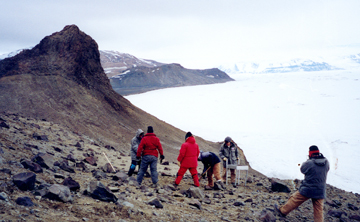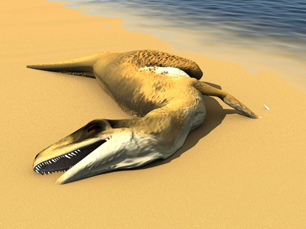 In December
2003, we traveled on a remarkable and arduous expedition to the southernmost
continent of the planet in search of marsupials. With the support of the U.S.
National Science Foundation, and Argentina’s Museo de La Plata and Instituto
Antártico Argentino, we hoped to find evidence of the pouched mammals
to help piece together their journey through the Antarctic millions of years
ago.
In December
2003, we traveled on a remarkable and arduous expedition to the southernmost
continent of the planet in search of marsupials. With the support of the U.S.
National Science Foundation, and Argentina’s Museo de La Plata and Instituto
Antártico Argentino, we hoped to find evidence of the pouched mammals
to help piece together their journey through the Antarctic millions of years
ago. Paleontologists screen rocks for the remaining bones of a meat-eating dinosaur found in the Naze, a peninsula on northern James Ross Island in Antarctica. Photo courtesy of James Martin.
Marsupials appear to have originated in North America, yet somehow are now mostly isolated on the continent of Australia. One hypothesis is that during the Late Cretaceous, sometime between 65 to 75 million years ago, a dispersal route extended from North America through South America, across Antarctica and into Australia. Marsupials followed the corridor, possibly in response to competition from nonpouched mammals.
In 1998, on an expedition to Vega Island, east of the Antarctic Peninsula, Dan Chaney of the Smithsonian Institution discovered a hadrosaurine dinosaur tooth. As the earliest appearance of these duckbilled dinosaurs is in North America, the hadrosaur tooth suggested that a dispersal route existed during the Late Cretaceous that would have allowed other creatures to migrate as well. However, one tooth, although extremely suggestive, was not enough evidence to confirm our migration hypothesis. Therefore, our 2003 expedition was launched to return to Vega Island in hopes of finding evidence of elusive marsupial mammals.
Just before Thanksgiving in 2003, members of the expedition crowded onto a research vessel, the Lawrence M. Gould, in Punta Arenas, Chile, for the voyage across the Drake Passage to Antarctica. The Drake Passage has the reputation of being one of the roughest crossings in the world; we were not disappointed. Four days and many queasy stomachs later, we arrived on the east side of the Antarctic Peninsula, but icebergs had blown into the Antarctic Sound, preventing us from getting all the way to Vega Island. We revised our schedule and headed for Palmer Station on the western side of the Antarctic Peninsula.
On the voyage along the western side of the peninsula, the scene was awe-inspiring, with iceberg-filled seas and islands possessing magnificent glaciers extending down to the sea. We saw seals, whales, penguins and many seabirds. The weather was fantastic on this side of the peninsula, but we knew we had to return to the stormy eastern side.
Once again, the Antarctic Sound was choked with icebergs, but our captain, Mike Terminal, maneuvered carefully through the iceberg fields by taking a different route through the islands and arriving in Herbert Sound in the Weddell Sea. We steamed toward Vega Island, but soon found the sea was still frozen.
Our ship was not an “icebreaker,” per se, but was rated to break foot-thick ice. So, we began the process of breaking our way toward Vega. We often would get stopped by the ice, go into reverse and plow ahead until we were stopped again. The ice became 3 to 4 feet thick, and finally we realized we could not make it to Vega Island. Our spirits dropped because we could see the island only a few miles ahead. Then, the ship got completely stuck.
The crew tried many different ways to free the ship, everything from attempting to tilt the ship to utilizing fire hoses filled with seawater to melt the ship out. All during this time, we thought of the stories of Ernest Shackleton and the Endurance crew’s miraculous survival in the early 1900s. Four hours later, the ship was freed thanks to the expertise of our captain and crew, and we returned to open water.
We now had to decide our next course of action, as it was clearly impossible to return to Vega Island. Our only recourse was to offload nearby onto James Ross Island. A northern peninsula of the island, the Naze, possessed Late Cretaceous rocks, but they were deposited in much deeper marine environments compared to those at Vega Island. Thus, we figured we probably would not find any terrestrial creatures, and that we would have to be content with marine reptiles and invertebrates.
The closest site where we could offload from the Zodiac boats was 4 miles from the Naze, and, due to the shallow sea, that site was 2 miles from the ship. We established camp — putting up cook tents, wash tents, storage tents, bathroom tents and sleeping tents. Following the daunting task of erecting a camp that would sustain us against the Antarctic weather for the next month, the ship disappeared, leaving us with a feeling of abandonment, which was quickly replaced by awe for the striking beauty around us.
Our new home was comfortable, and we found our Scott tents (named for the Antarctic explorer, Robert Scott, who froze to death in one) sturdy enough to withstand the harsh wind and snow. Very often, we would awake to 3 to 6 inches of snow covering the camp (which was christened Camp Slap Ya Mama for a Cajun seasoning that became very popular at mealtime). The dryness of Antarctica caused the snow to sublimate, and normally only a single field day was lost following snowstorms.
The food was very good and was not freeze-dried. We kept fresh meat in snowfields and got our drinking water from snowmelt. Camp life was usually fun and often when we were snowbound, we read, played games and, in particular, fulfilled our obligation to scientifically document and conserve the fossils we had found.
The areas we wished to survey for fossils were 4 miles away from our camp. Every day, we would hike at least 8 miles roundtrip to the Naze and back. Sometimes we would return to find our morning pathway had floated out to sea! We had hoped to find fossils from Cretaceous marginal marine sediments, but we encountered relatively few specimens. Day after day, we found little, we tired and ached, and began feeling our expedition would result in failure. But one afternoon, our luck changed — we found several bones of what appeared to be a medium-sized fossil reptile.
We were working in marine rocks, but the bones looked nothing like the extinct reptiles (mosasaurs and plesiosaurs) we had found previously. We all wanted to exclaim “dinosaur!” But finding a dinosaur in relatively deep marine environments was definitely unexpected. Finally, we recovered a diagnostic toe bone, and we all had to admit, as one graduate student proposed, that we had found a dinosaur!
We collected all we could before the day’s end and headed back to camp elated. The entire camp took on a new attitude; no longer was fatigue and pain a factor — now we looked forward to recovering more of the creature.
 For
the next several days, we returned to the dinosaur site and scoured the surface.
We also screened the loose material within a 100-foot radius of the find. As
a result, we found much of the lower legs, parts of vertebrae, cranial material
and some fragmentary teeth. In the field, the elements appeared like those of
a theropod dinosaur, but the foot structure seems very primitive for a carnivorous
dinosaur existing at the end of the Mesozoic. Removal of the fossils from the
rock is currently under way in our museum laboratory for comparisons with known
meat-eating dinosaurs.
For
the next several days, we returned to the dinosaur site and scoured the surface.
We also screened the loose material within a 100-foot radius of the find. As
a result, we found much of the lower legs, parts of vertebrae, cranial material
and some fragmentary teeth. In the field, the elements appeared like those of
a theropod dinosaur, but the foot structure seems very primitive for a carnivorous
dinosaur existing at the end of the Mesozoic. Removal of the fossils from the
rock is currently under way in our museum laboratory for comparisons with known
meat-eating dinosaurs. An artist’s rendering shows what a newly found theropod (meat-eating) dinosaur might have looked like when it died, around 70 million years ago. Paleontologists found the bones of the dinosaur on a trip to the Antarctic. They were there in hopes of discovering marsupial fossils that would provide evidence of a dispersal route from North America down to the Antarctic and then to Australia between 65 and 75 million years ago. Image courtesy of the National Science Foundation.
Overall, we are happy with our results. The dinosaur does not appear to be related to North American dinosaurs, as is the hadrosaur we had found previously. The new dinosaur appears to be a primitive holdover of the original Gondwanan dinosaur assemblage that existed before the dispersal route was established. Therefore, based upon the occurrence of the duckbilled dinosaur and the new dinosaur, we believe that the Antarctic fossil assemblage at the end of the Cretaceous is a melting pot of local species as well as those that dispersed from North America, through South America and on to Antarctica. If dinosaurs could made the sojourn, we think that marsupials were walking in their footsteps. And modern birds, which occurred in abundance in Antarctica before anywhere else in the world, may very well have been going the other way, migrating northerly along the coast to areas such as New Jersey, where their bones are rarely found in the fossil record.
Our expeditions to the continent of Antarctica, where penguins and seals now live, has brought us great information about animals in the distant past and showed that the world, and particularly Antarctica, was much warmer around 70 million years ago compared to the present. In the Late Cretaceous, Antarctica may have provided a transit route for life between the Americas and Australia just before the end of the Age of Reptiles. As a result, endemic species and immigrants were interacting, but they had only a short time before the terminal Cretaceous extinction 65 million years ago, when the dinosaurs disappeared. The modern birds and probably marsupials survived to colonize the post-Cretaceous landscape. To continue developing this idea, we return to Vega Island this month, once again in search of marsupials.

